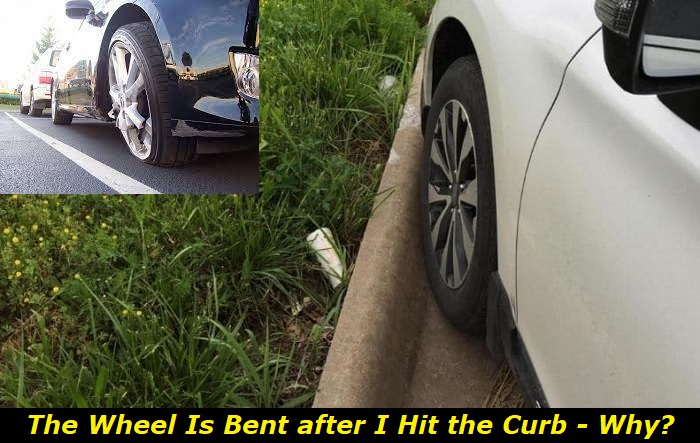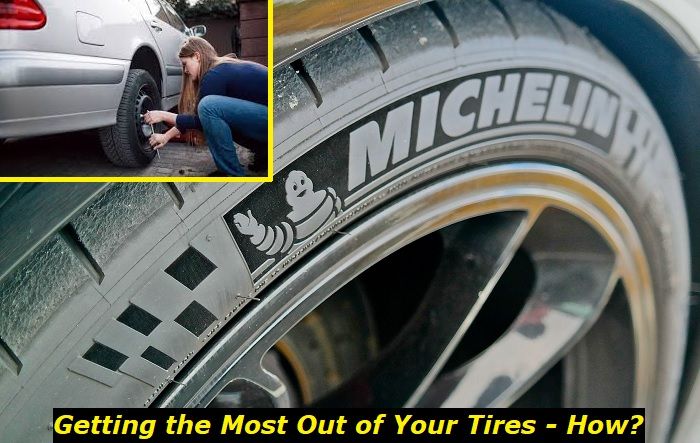Accidents happen, sometimes they're minor accidents and sometimes they're serious accidents. Even small accidents, such as hitting the curb, can cause some degree of damage to your vehicle. Sometimes, when you hit the curb, you might notice afterward that your wheel is bent inward. This is a serious problem that will stop you from driving your car normally. But what exactly is wrong when your wheel bends inwards after hitting the curb?
Wheel alignment problems highlights
- Level of importance:medium
- Commonreasons:hitting a curb, potholes, suspension problem, suspension repair
- DIY inspection:impossible
- DIY repair:impossible
- Average price in shops:$150 - $250
- Average time:0.5 - 1 hours
- If ignored:safety issues, tire wear, problems with steering

What Happened When You Hit the Curb?
It's easy to think that hitting a curb is a minor incident. However, it can cause serious damage to your car in several different ways. The most common issue after hitting a curb is the wheel bending inward. This can result in a lot of other problems, such as difficulty steering or driving, uneven tire wear, a flat tire, or even immobilization of the car.
Your wheel bending inward is caused by physical damage to the wheel itself or, damage to the supporting structures of the wheel, like the suspension.
If your wheel is bending inwards, you'll need to find the cause of the damage before you can start to repair it. You can start by inspecting the wheel for any signs. Look for dents, cracks, and other signs of visible damage.
What Could Be Wrong with the Wheel?
When hitting the curb, especially at high speed, many different parts could be damaged or affected. This is especially true depending on the type of car you drive, the type of suspension it uses, and whether the car uses front-wheel drive or rear-wheel drive.
Generally, hitting the curb does not only cause damage to the wheel. In fact, the most common cause of your wheel bending inwards is damage to the suspension system of the affected wheel.
Keep in mind that damage to one part of the suspension will often cause damage to another part. This means that the problem may be with multiple different parts, making it somewhat difficult to locate the cause of the problem.
Here are some of the most common reasons why your wheel might be bending inward after hitting a curb.
1) Damaged Control Arms
The control arms are a set of arms connected to a central pivot and used to control the angle of the wheels. The control arms are the most vulnerable point in the suspension, and the most likely to fail in such a collision. The most common cause of a wheel bending inward after a collision is a damaged control arm.
The control arms are also part of the steering system, so damage to the control arms could cause damage to the steering column or other steering components.
2) Steering Component Damage
If the wheel is bent, there is a good chance that there has also been some damage to one or more of the steering components.
If any of the steering components are damaged, it is likely that the tie rods will break, bend or fail first. You should also look for signs of red power steering fluid leaking.
You can also examine the steering system by getting into the car and examining the steering wheel. If the steering wheel feels stiffer or looser than usual, or if it is no longer aligned properly, then there could be damage to the steering column.
3) Damaged Strut
The strut is the part of the suspension that controls the vertical movement of the tire. Depending on the nature of the collision with the curb, the strut could take damage that affects the alignment of the wheel.
Look for damage to the strut mounting points, as well as bending or cracking on the body of the strut itself. Also, look for fluid leaks from the inside of the strut.
4) Bent Rim
The wheel itself could be cracked or damaged from the force of the collision with the curb. While tires are designed to absorb and dissipate impacts, the wheel could still be damaged by a sufficiently forceful collision with the sharp edge of a curb, or by an impact against the rim.
If the rim is damaged, it is likely that the integrity of the tire's seal will be broken, resulting in a flat tire. If there has been any sort of damage to the wheel or tire, then it will need to be replaced.
5) Wheel Misalignment
It's not uncommon for a tire to face the wrong direction after hitting a curb. This is the result of the tire being forced out of alignment by the impact.
The front wheels are the most common victims of curb collisions. If the front wheels are misaligned, it can cause difficulty in driving and steering. Because each tire will try to pull the car to move in its direction, this can cause serious strain on the suspension, and continuing to drive like this can cause premature wear on the tires.
The tire will need to be realigned by a mechanic.
6) Bent Car Frame
If you hit a curb at high speed, there is a chance that the frame of the car might end up bent or deformed. If the frame is only slightly bent, it could appear like the wheel is misaligned or pushed back slightly.
A bent frame is a very serious problem. To fix it, you will need to bring your car to a mechanic who will assess the extent of the damage and determine whether it can be repaired.
How to Fix the Problem
If your wheel is bending inward after hitting a curb, you'll need to get the problem fixed before you can trust your car on the road again. Damage to the suspension and steering system can be very serious and is often very hard to diagnose and repair. If you don't have sufficient knowledge or experience repairing similar issues, then you will need to have a mechanic examine your car for the underlying cause of the issue.
It's important to get the problem fixed as soon as possible, as driving with a bent wheel can cause further damage to your car. It's also dangerous as you could lose control of the vehicle. Getting the problem fixed on time will end up saving money in the long run as you will avoid further damage.
If the problem is with the wheel, then the solution will depend on the cause of the problem. If the wheel barrel is bent, it will need to be replaced or repaired, depending on the extent of the damage. If it is misaligned, then it will need to be realigned.
A damaged steering system will need to be examined by a mechanic, and the repairs necessary will depend on which parts of the system have been damaged.
No matter what the cause of the problem is, your mechanic will be able to recommend the best repair option based on the severity of the damage.
Even if you don't detect any damage from the collision with the curb, it is best to have a mechanic take a look at your car. There could be damage to the frame or suspension that you might not be able to see. This damage could worsen over time if it is not addressed on time.
Can I still drive my car if the wheel is bent?
Driving your car with a bent wheel should not be done, even for a short distance. Once the wheel is no longer properly aligned, it is dangerous to drive, as the vehicle's movements and turning become unpredictable. Damage to the steering column could also make the steering system less responsive.
There is also a high likelihood of causing further damage to your car if you continue to drive in this condition.
Can I prevent my wheels from getting damaged when I hit a curb?
The best way to prevent your wheels from getting damaged is to avoid hitting curbs altogether. Stay alert while driving and keep an eye on your surroundings.
Conclusion
Hitting a curb might seem like a minor incident, but it can cause serious damage to your vehicle, including your wheel bending inward. This is a clear indication of physical damage to the wheel or damage to the supporting structures, such as the suspension.
When inspecting the car, it is important to check for damage to the control arms and struts, as these are the most commonly damaged components. You should also check the steering components, rims, and car frame.
It is crucial to diagnose the problem accurately and efficiently. Having a qualified mechanic examine the car is the best way to deal with this issue.
About the authors
The CarAraC research team is composed of seasoned auto mechanics and automotive industry professionals, including individuals with advanced degrees and certifications in their field. Our team members boast prestigious credentials, reflecting their extensive knowledge and skills. These qualifications include: IMI: Institute of the Motor Industry, ASE-Certified Master Automobile Technicians; Coventry University, Graduate of MA in Automotive Journalism; Politecnico di Torino, Italy, MS Automotive Engineering; Ss. Cyril and Methodius University in Skopje, Mechanical University in Skopje; TOC Automotive College; DHA Suffa University, Department of Mechanical Engineering






Add comment